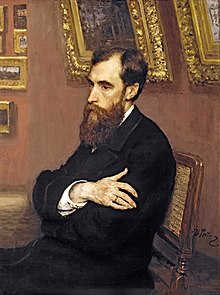Pavel Tretyakov
This article needs additional citations for verification. (March 2008) |


Pavel Mikhaylovich Tretyakov (
Childhood
Together with other Moscow businessmen he acted as the founder of the Moscow Merchant Bank (becoming one of its heads), the Moscow commercial and industrial company, some other large firms. He amassed a considerable fortune (4.4 million rubles), consisting of real estate (5 houses in Moscow), securities, money and bills.
Collecting art
Tretyakov started to collect art in 1854 at the age of 22; his first purchase was 10 canvases by Old
In 1870-80 Tretyakov also began to collect illustrations (471 by 1893), and in 1890 he began to collect icons. During his lifetime they were kept in his study and were not put on public display. He also had a small collection of sculpture (9 sculptures by 1893).
At first the gallery was located in Tretyakov's house in Lavrushenski pereulok. But as his collection expanded he decided to reconstruct his house to accommodate it. In 1870-1880 the house was reconstructed a number of times by the architect Kaminski.
Tretyakov wanted to transfer the gallery to the city as discreetly as possible, without any fuss; he didn't want to be in the centre of general attention and an object of gratitude. But this was not possible and he was very dissatisfied.
From 1881 his gallery became popular (by 1885 it was visited by about 30 thousand people). In 1892 Tretyakov inherited a collection of Western European painting from his brother and placed it in two halls of the western school. The collection in Tretyakov's gallery was equal in importance with the largest museums in Russia at that time, and became one of sights of Moscow. In August 1892 Tretyakov donated his collection and a private residence to Moscow. By then in the collection there were 1287 pictures and 518 graphics of the Russian school, 75 pictures and 8 figures of the West-European school, 15 sculptures and a collections of icons.

On 15 August 1893 the official opening of a museum under the name "Pavel and Sergey Tretyakov City art gallery" (nowadays
Other work
Apart from engaging in collecting, Tretyakov was active in charity. Charity for him was as natural as the creation of a national gallery.
He was an honorary member of the Society of Collectors of the Applied Arts and of the Musical Society from the dates of their foundations. He granted large amounts of money to these organizations, supporting all their educational undertakings. He supported an initiative to help the families of soldiers who died during the
With his brother Sergey he supported the Moscow School for the Deaf, founded in 1860 by the artist Ivan Karlovich Arnold, and became its patron. In 1900 the school was renamed the Arnoldo-Tretyakov School.
Death and legacy
Pavel Tretyakov died in December 1898, and his funeral was held at the
Tretyakov bequeathed half of his estate to charitable purposes. He provided for the financing of the gallery, and also for a shelter for the widows, juvenile children and unmarried daughters of artists who had died.[citation needed]
In his will he also provided large sums for the school for the deaf. He bought a big stone house with a garden for the school. 150 boys and girls lived in this house. Here they were looked after till they reached the age of 16. Tretyakov selected the best teachers, and became acquainted with the methods of study.[citation needed]
A
His daughter Vera married the pianist and composer
References
- ^ Fedotova, Y. (2019-10-04). "Who were the Peredvizhniki and why were they so important in Russian art?". Russia Beyond The Headlines. Retrieved 2020-02-19.
- ^ Lebedeva, Elena (18 December 2006). "Храм Святого Николая Чудотворца В Толмачах" [Church of St. Nicholas the Wonderworker in Tolmachi]. pravoslavie.ru (in Russian). Retrieved 11 August 2019.
- ISBN 3-540-00238-3.
